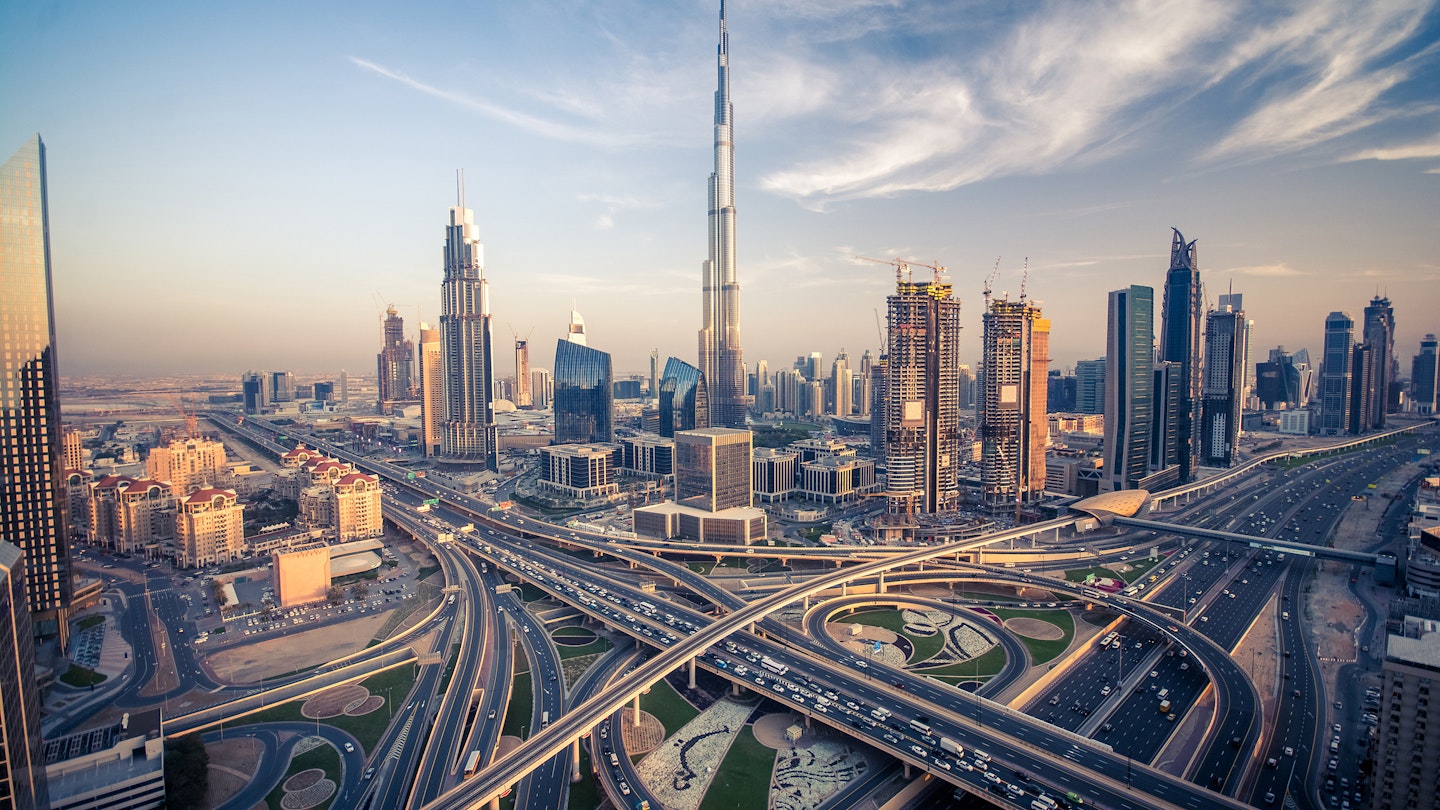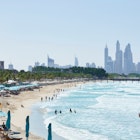Dubai has a population similar to that of Chicago, Berlin and Madrid, but it's so spread out that it consumes up to six times the square mileage compared with those cities. Getting around Dubai requires some form of transport, whether that's taking a taxi, using rideshare apps like Uber or Careem, hopping on public transport or driving yourself.
Here are the best ways to get around Dubai.
Editor's note: During COVID-19, please check the latest travel restrictions before planning any trip and always follow government health advice. Events may be subject to change.

Car
Well-maintained multi-lane highways, plentiful gas stations and cheap gas make renting a car a worthwhile option for day trips from Dubai. But driving in Dubai itself is not for nervous nellies given that local behind-the-wheel styles are rather quixotic, and negotiating seven- or eight-lane highways can be quite scary at first. Distances can be deceiving. Heavy traffic, detours and eternal red lights can quickly turn that three-mile trip into an hour's journey.
Traffic congestion in Dubai can be a nightmare at peak hours, that is between 7am and 9am, 1pm and 2pm and most of the evening from 5pm onward. Roads are also clogged on Friday afternoon, especially around shopping malls, beaches and family attractions.
There are scores of car rental agencies in Dubai, from major global companies to no-name local businesses. For navigating, Google Maps works reasonably well. A local alternative is the RTA Smart Drive app, downloadable free from Google Play and the Apple app store.

Taxi
Dubai is a taxi-centric city, and you're likely to find yourself in need of a cab at some point. Taxis are the fastest and most comfortable way to get around Dubai, except during rush-hour traffic. Government-licensed vehicles are cream-colored and operated by Dubai Taxi Corporation. They are metered, air-conditioned and relatively inexpensive. Taxis can be hailed in the street, picked up at taxi ranks or booked by phone. You'll also see private taxis with different-colored roofs (for example, Arabia Taxi has a green roof). These are licensed and fine to use.
Dubai's Roads & Transport Authority has introduced a free Smart Taxi App from which you can book the nearest taxi based on your location. It's available on Google Play and the Apple App Store.
It’s generally fine for women to ride alone in a taxi, even at night, but you should not sit in the front as this might be misunderstood. Although drivers rarely get touchy or physically aggressive, some may try to hit on you. If you prefer, book a pink-roofed cab with a woman driver – a so-called Ladies Taxi.
Uber and Careem
As in other cities, taxis in Dubai are facing stiff competition from mobile ride-hailing apps such as Uber and Careem. Careem was founded in Dubai in 2012, and in early 2020 it was purchased by Uber, but the brands are maintained separately. Cost-wise, there's little difference between calling a taxi or using a rideshare app, but Uber and Careem tend to have much nicer vehicles that often come with free water, phone chargers and more clued-up drivers.

Dubai Metro
Dubai’s public transport is operated by the Roads & Transport Authority and consists of the Dubai Metro, buses, water buses and tram. For trip planning, you can download the RTA app S'hail, which provides all local transport options on one platform, plus taxi bookings and real-time traffic conditions. Before hopping aboard local transport, purchase a rechargeable pass (Nol Card; nol is Arabic for "fare") from ticket offices or vending machines. The RTA network is divided into seven zones, with fares depending on the number of zones traveled.
The Metro is cheapest way to get around Dubai. It has two lines, the Red Line and the Green Line, with trains that run about every ten minutes. Dubai Metro links all neighborhoods, with the Red Line stopping at or near major sights along Sheikh Zayed Road and in the neighborhoods of Bur Dubai and Deira. At each station, cabs and feeder buses stand by to take you to your final destination.
Each train consists of four standard cars and one car that’s divided into a women-only section and a "Gold Class" section, where a double fare buys carpets and leather seats. Women may of course travel in any of the other cars as well. Huge murals decorate some of the Dubai Metro support pillars, adding a bright spot of color to the city.
Top neighborhoods to explore in Dubai
Bus
The RTA operates buses on more than 120 routes primarily serving the needs of low-income commuters. Buses are clean, comfortable, air-conditioned and cheap, but they’re slow. The first few rows of seats are generally reserved for women and children. Fares range from Dhs3 (80 cents) to Dhs8.50 ($2.30), and Nol Cards must be used.
If you're wanting to go further afield, RTA also runs a public bus between Dubai and Muscat, the capital of Oman.

Boat
Abras are motorized traditional wooden boats that connect the two sides of Dubai Creek and are one of the most fascinating ways to travel in Dubai. A handful of routes link the neighborhoods of Bur Dubai and Deira and are great for shoppers looking to visit the markets on both shores. The abra ride is quick, taking less than ten minutes, and costs Dhs1 (30 cents) or Dhs2 (55 cents) depending on the route. Abras leave when full (around 20 passengers), which rarely takes more than a few minutes.
Around Dubai Marina, the air-conditioned Dubai Marina Water Bus links four stops every 15 to 20 minutes. Nol Cards can be used on the Water Bus.
16 best cheap things to do in Dubai

Monorail
The elevated, driverless Palm Jumeirah Monorail connects the Palm Jumeirah with Dubai Marina. There are four stations: Palm Gateway near the bottom of the "trunk," Al Ittihad Park near the Galleria Mall, Nakheel Mall and Atlantis Aquaventure at the Atlantis The Palm hotel. An additional station, The Pointe, is expected to be up and running soon. The 3.5-mile trip takes about 12 minutes and costs Dhs20 ($5.45). Trains run every 15 minutes. The monorail connects to the Dubai Tram at Palm Gateway.
Tram
The Dubai Tram makes 11 stops in and around the Dubai Marina area, including near the Marina Mall, The Beach at JBR and The Walk at JBR. It also connects with the Damac and DMCC Dubai Metro stations and with the Palm Jumeirah Monorail at Palm Jumeirah station. Trams run roughly every eight minutes, and the entire loop takes 40 minutes. The fare depends on how many zones you travel through, starting at Dhs4 ($1.10) for one zone. Nol Cards must be used.

Bicycle
Dubai has had a bicycle-sharing scheme since 2013 and was the first city in the Middle East to launch one. The current iteration is run by RTA and Careem and has brought a fleet of nearly 800 pay-as-you-go bicycles to Dubai's streets. The goal in the next five years is to have 3500 rentable bicycles as part of the scheme, which can be docked at 350 solar-powered stations across the city. The government has made cycling one of its priorities and has already constructed 265 miles of biking paths across Dubai, with plans to expand to more than 400 miles by 2023.

Walking
Walking in Dubai, even combined with public transport, is not easy because of the lack of sidewalks, traffic lights and pedestrian crossings. It is not unheard of here to be forced to take a taxi merely to reach the other side of the road. But some of Dubai's neighborhoods, especially the older sections of town and the restored historic districts, are better suited for pedestrians. The best walking areas are Dubai Marina, City Walk, Al Fahidi Historic District, Al Seef and Deira.
Accessible transportation in Dubai
In recent years, the government has launched several initiatives to make Dubai more accessibility-friendly through the Dubai Disability Strategy. However, drop-down curbs are still rare and practically nonexistent in the older neighborhoods of Bur Dubai and Deira. Dubai Taxi has a limited supply of "special needs taxis" – vans with wheelchair lifts – but they must be ordered several hours in advance. Some local buses and all water buses are wheelchair accessible. Dubai Metro has elevators and grooved guidance paths in stations and wheelchair spaces in each train compartment. Most parking areas in Dubai contain spaces for drivers with disabilities.
Click here to download Lonely Planet's free Accessible Travel guide.
You might also like:
Enjoy a comfortable layover in Dubai with a free hotel stay
Top 10 things to know before visiting Dubai
Where to experience authentic Dubai











